Learn how to dispose of and replace old fire extinguishers in compliance with California law and best practices
Fire extinguishers contain potentially dangerous chemicals at high pressures. Yet each state has a slightly different take on how to safely get rid of an old, obsolete, or expired fire extinguisher—and California is no exception. A mélange of federal guidelines, state programs, and local hazardous waste rules govern their recycling, disposal, and replacement. In this article, we explain how to dispose of fire extinguishers in California and what kinds of extinguishers you should pick to replace them.
We also provide an overview of critical regulations and programs, including municipal hazardous waste disposal requirements, rules from the United States Environmental Protection Agency (EPA), and guidelines from the California State Fire Marshal’s fire extinguisher program.
If it’s time to replace some of your fire extinguishers, take a look at our ABC dry chemical, CO2. and Purple K fire extinguishers. We also carry a full line of fire extinguisher cabinets, covers, and brackets to keep your equipment protected and secure.
Why does proper disposal and replacement of fire extinguishers matter?
The pressurized contents of a fire extinguisher can be lethal
Fire extinguishers that are carelessly discarded while still under pressure can explode. A typical 20-pound ABC fire extinguisher has an operating pressure of over 150 pounds per square inch—pressure that has to go somewhere if the extinguisher is crushed or damaged. In London, England, an extinguisher found its way into a garbage truck, where it exploded as the compactor crushed the metal cylinder. Waste sprayed from the back of the vehicle, but the sanitation workers were lucky: no one was injured or killed.
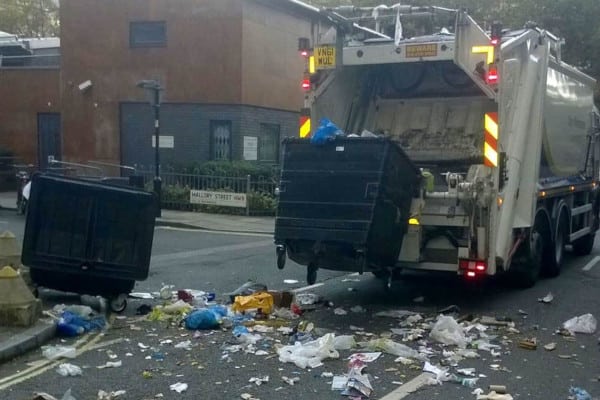
But the metal shell of a typical fire extinguisher can easily turn into a lethal projectile. According to a 2014 accident report from the Occupational Safety and Health Administration (OSHA), an employee working at an Army Reserve facility was killed by an extinguisher left in a dumpster. The device exploded during a dumping operation, fatally striking the skull of a 42-year-old forklift operator.
The chemicals in a fire extinguisher can be an environmental hazard, but most aren’t hazardous waste under state and federal law
Each fire extinguisher contains a substance, or “agent,” that’s designed to fight specific kinds of fires. Those agents may be harmless (like water) or hazardous (like many chemicals). Most agents—save for carbon dioxide or water-only types—can sometimes pose a threat to people, animals, or the environment. Many safety data sheets (SDSs) warn that discharged agents should be bagged (or drummed) and kept out of waterways.
According to the EPA, hazardous waste has one or more of the following characteristics:
- Ignitability: Can it create fire?
- Corrosivity: Will it cause metals to rust?
- Reactivity: Can it explode or generate toxic fumes when heated, compressed, or combined with water?
- Toxicity: Is it harmful when ingested or absorbed?
Under federal and California state law, most extinguishing agents are not harmful enough to be treated as hazardous waste. But here’s a run-down of the environmental threats posed by common fire extinguisher types:
ABC dry chemical: not typically hazardous waste. This common extinguisher type often contains monoammonium phosphate (MAP), a corrosive material that can irritate the eyes, skin, or respiratory tract. However, the Environmental Protection Agency (EPA) doesn’t consider MAP hazardous waste.
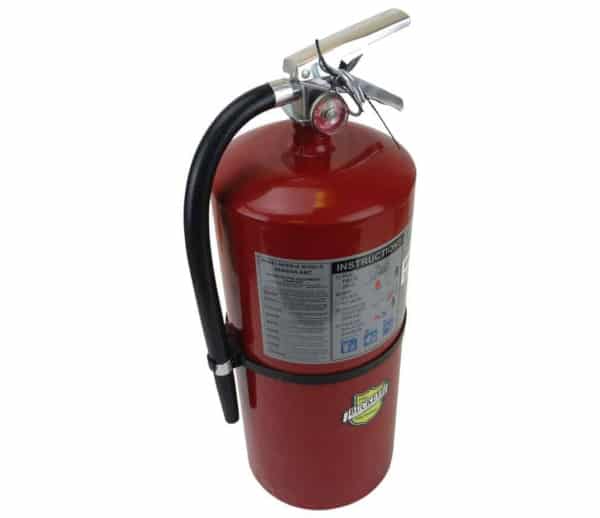
- Carbon dioxide (CO2): not hazardous waste. Releasing too much CO2 gas in a confined space can lead to suffocation—and spraying it on the skin can cause frostbite. But it’s not hazardous waste, according to the EPA. It won’t contaminate waterways or soil and doesn’t pose a threat to the ozone layer.
- Dry powder: check the SDS. Each dry powder (or Class D dry powder) extinguisher combats fires in specific types of metals. They use a wide variety of firefighting agents that may or may not pose an environmental threat.
- Foam: check the SDS. Foam extinguishers may contain perfluorooctanoic sulfonate (PFOS) or perfluorooctanoic acid (PFOA), which are both soil and groundwater contaminants in many states. But many foams—even those made from safer chemicals—shouldn’t be discharged into waterways or to waste treatment plants.
- Halon: requires professional disposal. The EPA requires that halon be disposed of “using one of several controlled processes.” It’s a hazard to the ozone layer—a part of the earth’s atmosphere that absorbs ultraviolet radiation—and must be handled by trained technicians.
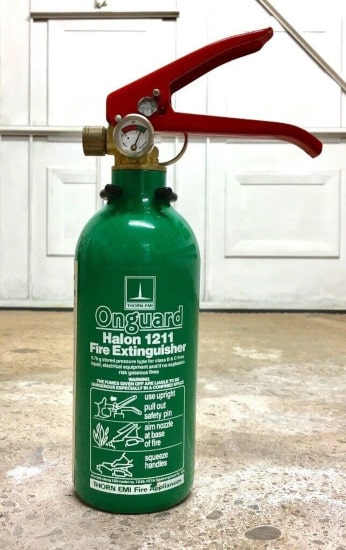
- Halotron: environmentally safe. Halotron I is American Pacific Corporation’s brand name for a gas used in place of halon. Unlike halon, Halotron poses no known threat to the environment.
- Purple-K: not typically hazardous waste. Potassium bicarbonate, or “Purple-K,” fights Class B and C fires. The EPA doesn’t consider it a hazardous substance.
- Wet chemical: not typically hazardous waste. These extinguishers are used on Class K (kitchen) fires. Do not confuse them with Purple-K! They often contain potassium acetate and potassium citrate, which aren’t federally listed as hazardous substances.
- Soda acid, carbon tetrachloride, and other obsolete types: possibly hazardous waste. Some models should have been disposed of years ago—and may even explode during handling. Facility managers who find these devices should seek expert advice regarding their disposal.
How should consumers and facility managers dispose of fire extinguishers in California?
Start by identifying your extinguisher type. An extinguisher’s label will generally describe what’s inside—if only in small print—as the label below shows.
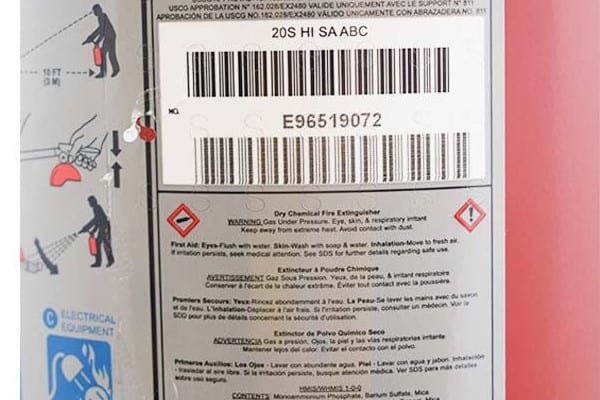
If those fire extinguishers don’t work or don’t comply with fire code, consider the following:
Should the extinguisher be refilled?
If a fire extinguisher is of an approved type and can be serviced, refilled, and successfully inspected, it can be placed back into service. However, some can’t be recharged (disposable types) or shouldn’t (because they’re no longer permitted). If a fire extinguisher has been fully or partially discharged while fighting a fire, a recharge may not always make sense. The cost of refilling it—or the condition or age of the fire extinguisher—may make replacement the wiser choice. For more info, take a look at our guide to fire extinguisher recharges.
What kinds of disposal programs are available locally?
It may be tempting to empty an old fire extinguisher and toss the canister in the trash. That’s never an option with halon-filled models. These types must be “returned to the manufacturer or local fire extinguisher distributor having the capability of recovering the halogenated agent,” according to the California regulations.
Further, some local governments in California treat all fire extinguishers as hazardous waste—empty or full. But a local fire equipment company, government facility, or waste management company may be willing to take them at little or no cost. They may also be able to recover the remaining chemicals and gases in an environmentally sound way.
Riverside County, California is typical of many local governments in California that operate hazardous waste programs. The county provides a list of transporters who can safely handle fire extinguishers and their chemical contents. Similarly, Los Angeles County treats extinguishers as hazardous waste and provides permanent collection centers where they can be disposed of.
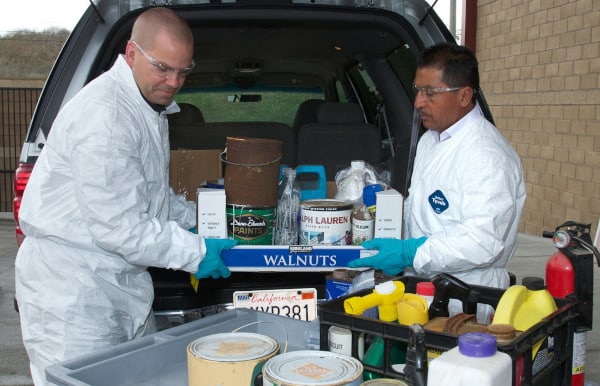
Many such programs deal with household hazardous waste. So, those who manage large residential facilities or commercial buildings of a certain size may need to work directly with a hazardous waste transporter or fire supply company.
Business owners or facility managers struggling to determine which laws apply may need to reach out to local sanitation officials. Riverside County, for example, employs regulatory assistance officers who help businesses properly classify and dispose of these materials. When that fails, local fire departments—or companies specializing in extinguisher disposal or recycling—may be able to help.
When replacing California extinguishers, which rules apply?
Companies and technicians in the fire extinguisher business need approval from the state. As part of its efforts to protect residents from fire, California’s Office of the State Fire Marshal sets standards for extinguishing equipment via its fire extinguisher program. Licenses and certifications issued through the program help ensure that any extinguisher serviced or sold in the state meets rigorous manufacturing and performance standards.
Some rules apply to all commercial, industrial, and large residential buildings, while others are reserved largely for workplaces. The 2019 edition of the California Fire Code (enforced beginning in January 2020) regulates fire extinguisher selection. In the workplace, there’s also the California Division of Occupational Safety and Health (DOSH or Cal/OSHA). DOSH provides yet another set of regulations pertaining to selection, distribution, and inspection of fire extinguishers in California for industrial and commercial workers, along with civilians in public spaces including “elevators, amusement rides, and tramways.”
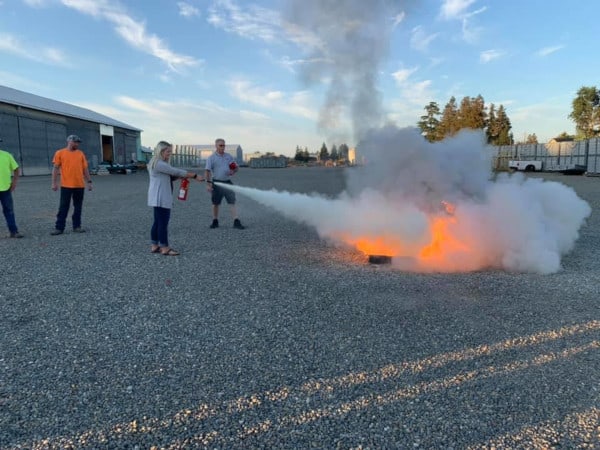
Both local governments and state officials have a say. The California Office of the State Fire Marshal’s Fire Extinguisher Law & Regulations explain that any jurisdiction may regulate “the number, size, and type of portable fire extinguishers required to be installed or provided.” Local fire departments and fire professionals can help building owners find solutions that comply with all of these rules.
How do I choose the right fire extinguishers?
Our guide to extinguisher selection and placement explains how ease of access and a building’s specific hazards form the basis of today’s extinguisher fire codes. While it’s based on standards from the National Fire Protection Association (NFPA)—not California code—the rules are, by and large, similar. Both contain numerous requirements about how many fire extinguishers are required, where the facility manager should place them, and how they should be labeled and stored.
Here’s how the 2016 and 2019 editions of the California Fire Code break down the types of extinguishers approved for the five classes of fires (section 906.2 in both editions):
Areas at risk for wood, paper, cloth, and other Class A (ordinary combustible) fires may be protected by:
- Water-type (Class A-rated water or foam-based) agents
- Halogenated agents
- Multipurpose dry chemical (ABC dry chemical) extinguishers
- Multipurpose wet chemical (ABC wet chemical) extinguishers
Areas at risk for Class B fires (those involving flammable liquids and gases, save for cooking oils and fats) should be protected by:
- Class B water-type (foam) agents
- Halogenated agents
- Carbon dioxide extinguishers
- Dry chemical extinguishers
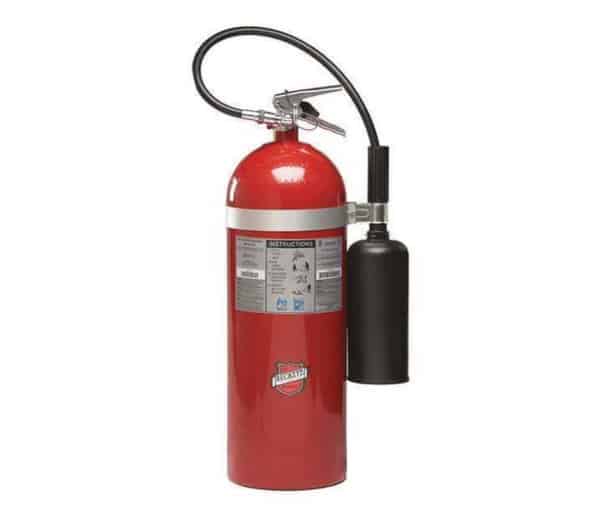
Where fires are likely to involve electrical hazards (i.e. situations where a Class A or B fire might also involve electrically powered equipment), California fire code permits the use of:
- Class C water-mist extinguishers
- Halogenated agents
- Dry chemical agents
- Carbon dioxide extinguishers (excluding those with metal horns, which may conduct electricity)
When fires may involve combustible metals—an unusual situation—consumers must select a Class D extinguisher or extinguishing agent “approved for use on the specific combustible-metal hazard.” Because the right chemical depends on the type of metal, industrial or commercial operations that handle combustible metals should seek specific advice from fire safety professionals.
Finally, where extinguishers protect against fires in “vegetable or animal oils and fats,” they must “be listed and labeled for Class K fires.” More often than not, those extinguishers use wet chemical agents.
Fire extinguishers that meet California’s fire code requirements are readily available
California’s fire safety rules are complex. But with a little research and a little help from local experts, it’s possible to safely dispose of and replace fire extinguishers. If you’re in the market for a new extinguisher that complies with California Fire Code, QRFS has models in stock for Class A, B, and C fires, including:
- Dry chemical ABC extinguishers for solid fuels, flammable liquids, and electrical fires
- Carbon Dioxide (CO2) extinguishers for clean extinguishing of flammable liquid and electrical fires
- Purple K dry chemical extinguishers designed to perform against the toughest Class B and C fires
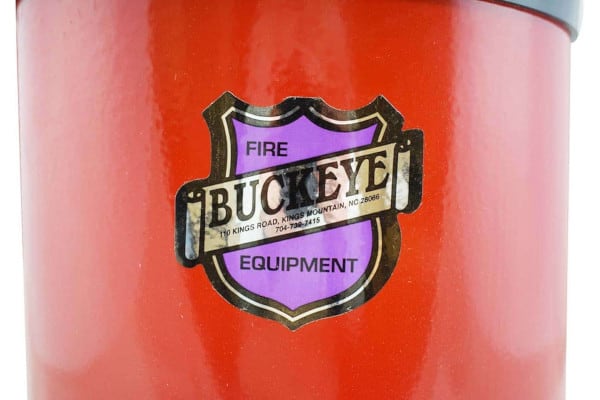
Other types of fire extinguishers are available by special order—by contacting us either at support@qrfs.com or 888-361-6662—including:
- Halotron for Class A and Class B fires where it’s important to avoid contamination of electrical equipment
- Dry Powder and Class K extinguishers for Class K fires involving cooking grease
- Other types of specialty extinguishers and fire safety equipment that meet the requirements of the California Fire Code, the California State Fire Marshal, and local authorities
Finally, while disposal is an inevitable part of owning a fire extinguisher, our cabinets, covers, and other accessories can keep these life-saving devices fire-ready for years to come.
Browse our selection of fire extinguishers and accessories.
This blog was originally posted at blog.qrfs.com. Did it help you understand how to dispose of a fire extinguisher in California? Let us know, and check us out at Facebook.com/QuickResponseFireSupply or on Twitter @QuickResponseFS.


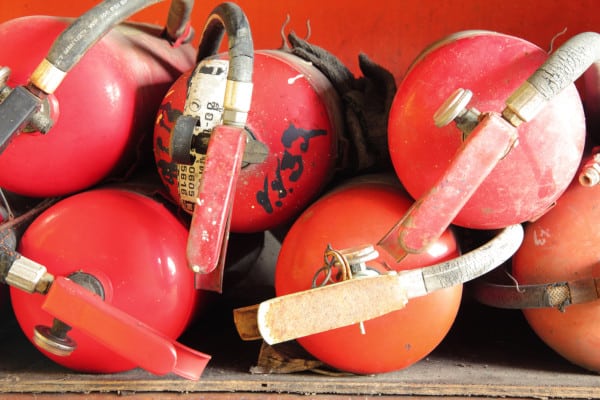
I have an old fire extinguisher. The yellow tag says March 23, 2005.
How do I dispose of it in Berkeley, Ca.?
Thanks for your help!
Mary — You can try a local fire extinguisher distributor, the fire department, a local recycling company, or a government collection center. Put in your zip code at this resource and it shows you recycling/disposal facilities.
That link for recycling fire extinquishers came up as an unsafe website – possibly a phishing scam, or maybe website not configured right.
Thanks Dennis — we attempted to go through the links to check them but did not see any flagged issues. We did remove one potential link that is not necessary; but can you specify which word(s) is linked that you are seeing an issue with? Thanks!
The Guide is really helpful! Especially the edition section and classes mentioned in that section. I am not aware of that.
I work for one of the largest fire department in California. Please do not bring to die station. We do not take them.
I work for the US Navy and am looking for a place that recycles old fire extinguishers. We have over 500 and no one wants anything to do with them. Does DRMO or HAZMAT dispose of these?
Thomas — we aren’t aware of the federal or DOD-specific procedures for disposing of or recycling fire extinguishers; but the typical method for civilians is to search for a hazardous waste collection service (often local government or company) that can handle it. Thanks for commenting.